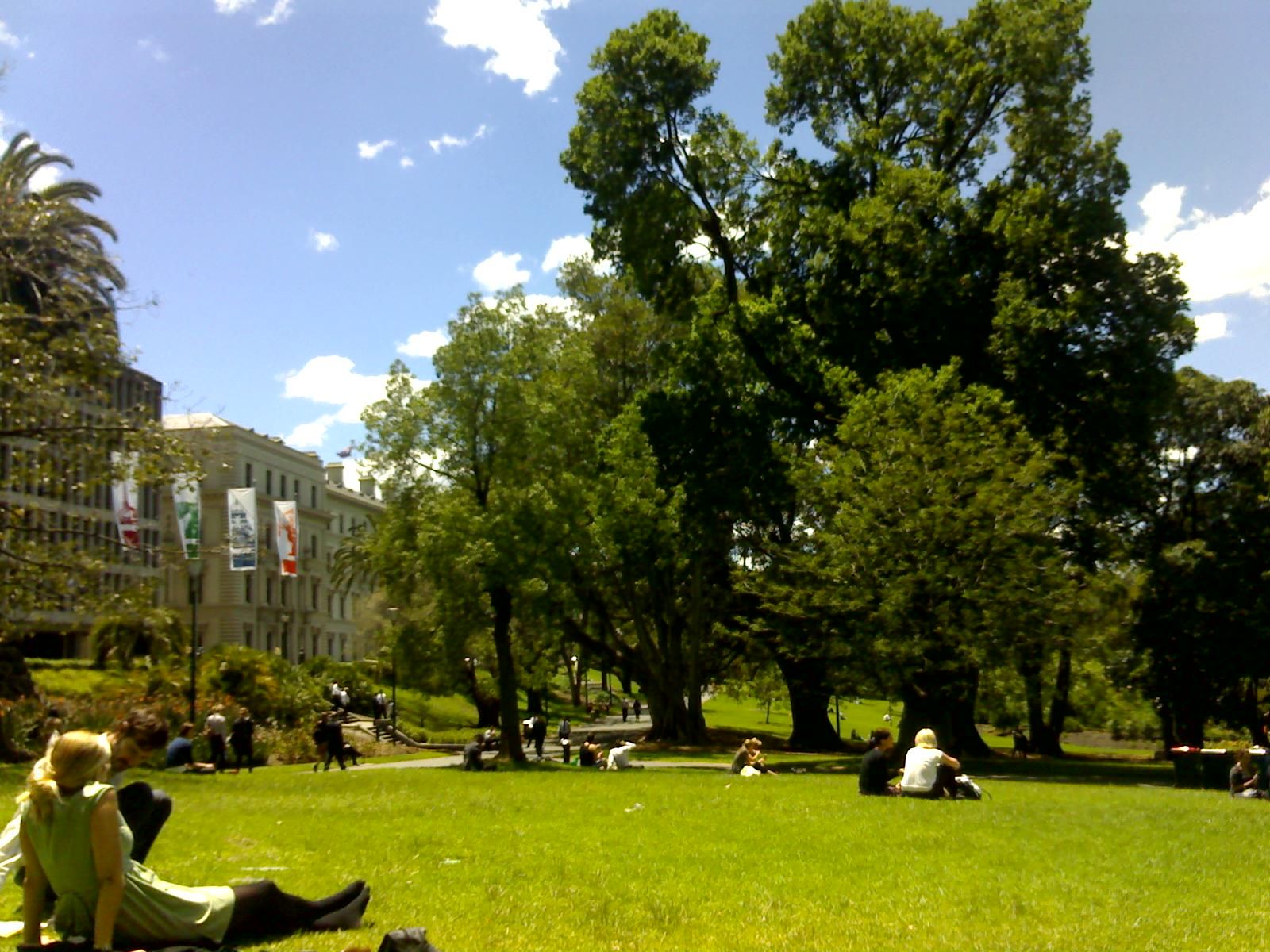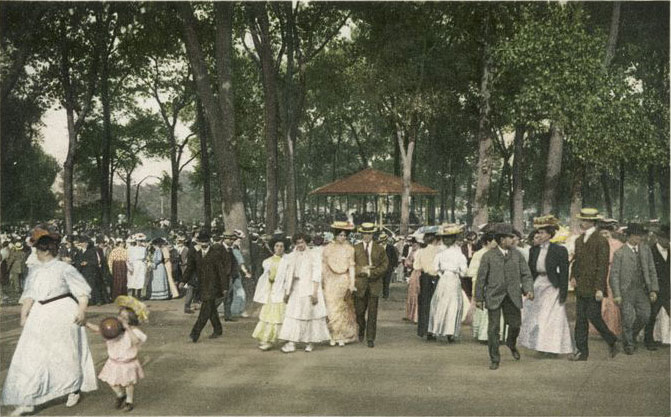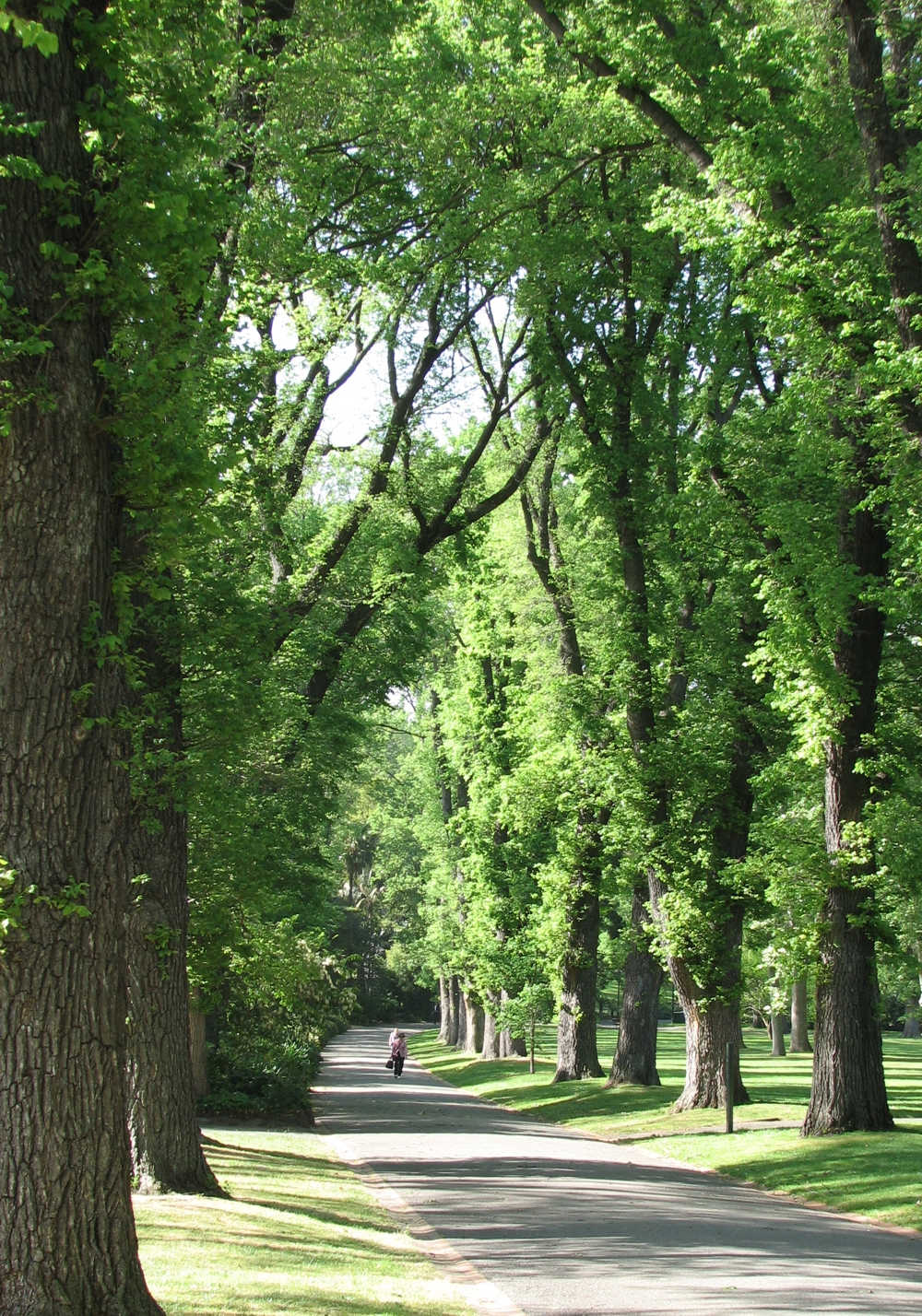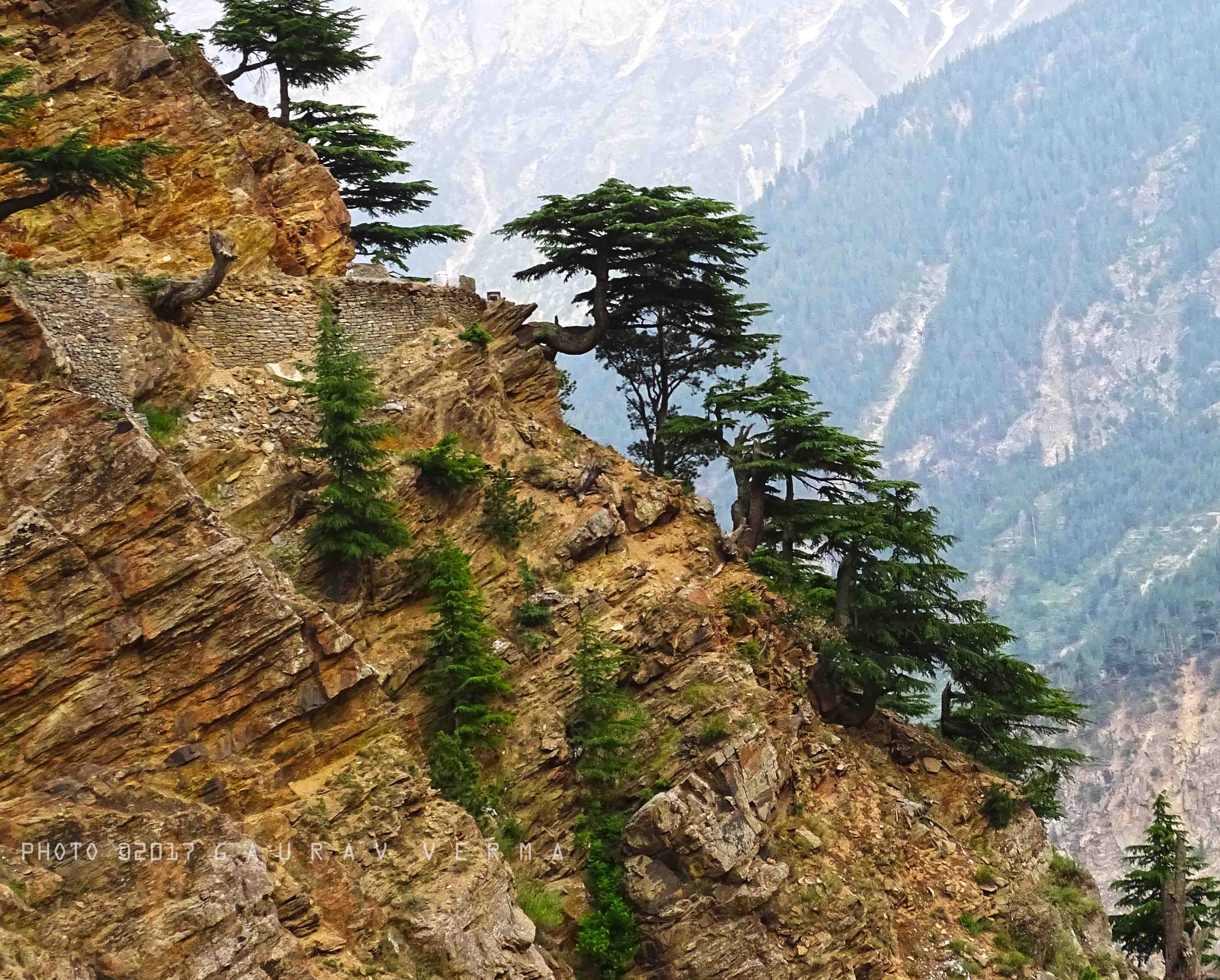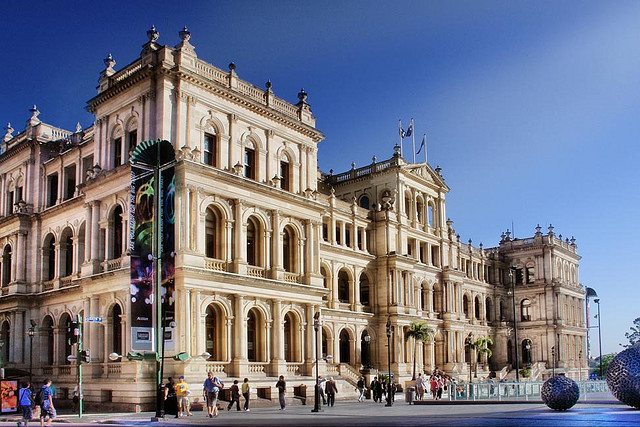|
Treasury Gardens
The Treasury Gardens consist of on the south-eastern side of the Melbourne central business district, East Melbourne, Victoria, Australia. The gardens are bounded by Wellington Parade, Spring Street, Treasury Place, and by the Fitzroy Gardens across Lansdowne street to the west. They form part of a network of city gardens including Fitzroy Gardens, Carlton Gardens, Flagstaff Gardens and Kings Domain. The gardens are listed on the Australian National Heritage List and the Victorian Heritage Register for their historical, archaeological, social, "aesthetic and scientific (horticultural) importance for its outstanding nineteenth century design, path layout and planting". Description The Gardens are a short walk from Victoria’s Parliament House and are overlooked by the Old Treasury Building and State Offices. They create a landscaped setting for office workers to enjoy during lunch with large areas of lawn and walking paths lined with mature trees. Due to their central l ... [...More Info...] [...Related Items...] OR: [Wikipedia] [Google] [Baidu] |
Urban Park
An urban park or metropolitan park, also known as a city park, municipal park (North America), public park, public open space, or municipal gardens (United Kingdom, UK), is a park or botanical garden in cities, densely populated suburbia and other municipal corporation, incorporated places that offers open space reserve, green space and places for recreation to residents and visitors. Urban parks are generally Landscape architecture, landscaped by design, instead of lands left in their natural state. The design, operation and maintenance, repair and operations, maintenance is usually done by government agencies, typically on the local government, local level, but may occasionally be contracted out to a park conservancy, "friends of" group, or private sector company. Depending on size, budget, and land features, which varies considerably among individual parks, common features include playgrounds, gardens, hiking, running, fitness trails or paths, bridle paths, sports fields and c ... [...More Info...] [...Related Items...] OR: [Wikipedia] [Google] [Baidu] |
Fitzroy Gardens
The Fitzroy Gardens are 26 hectares (64 acres) located on the southeastern edge of the Melbourne central business district in East Melbourne, Victoria, Australia. The gardens are bounded by Clarendon Street, Albert Street, Lansdowne Street, and Wellington Parade with the Treasury Gardens across Lansdowne street to the west. The gardens are one of the major Victorian era landscaped gardens in Australia and add to Melbourne's claim to being the ''garden city'' of Australia. Set within the gardens are an ornamental lake, a scarred tree, a visitor information centre and cafe, a conservatory, Cooks' Cottage (a house where the parents of James Cook lived, brought from England in the 1930s), tree-lined avenues, a model Tudor village, a band pavilion, a rotunda, the "Fairies' Tree", fountains and sculptures. Horticulture The most notable feature of the Gardens is the trees that line many of the pathways. The land was originally swampy with a creek draining into the Yarra River. The ga ... [...More Info...] [...Related Items...] OR: [Wikipedia] [Google] [Baidu] |
Port Jackson Fig
''Ficus rubiginosa'', the rusty fig or Port Jackson fig (''damun'' in the Dharug language), is a species of flowering plant native to eastern Australia in the genus ''Ficus''. Beginning as a seedling that grows on other plants (hemiepiphyte) or rocks (lithophyte), ''F. rubiginosa'' matures into a tree high and nearly as wide with a yellow-brown buttressed trunk. The leaves are oval and glossy green and measure from long and wide. The fruits are small, round, and yellow, and can ripen and turn red at any time of year, peaking in spring and summer. Like all figs, the fruit is in the form of a syconium, an inverted inflorescence with the flowers lining an internal cavity. ''F. rubiginosa'' is exclusively pollinated by the fig wasp species ''Pleistodontes imperialis'', which may comprise four cryptospecies. The syconia are also home to another fourteen species of wasp, some of which induce galls while others parasitise the pollinator wasps and at least two species of ... [...More Info...] [...Related Items...] OR: [Wikipedia] [Google] [Baidu] |
Ulmus × Hollandica
''Ulmus'' × ''hollandica'' Mill. , often known simply as Dutch elm, is a natural hybrid between wych elm (''U. glabra'') and field elm (''U. minor'') which commonly occurs across Europe wherever the ranges of the parent species overlap. In England, according to the field-studies of R. H. Richens, "The largest area f hybridizationis a band extending across Essex from the Hertfordshire border to southern Suffolk. The next largest is in northern Bedfordshire and adjoining parts of Northamptonshire. Comparable zones occur in Picardy and Cotentin in northern France". Crosses between ''U.'' × ''hollandica'' and either of the parent species are also classified as ''U.'' × ''hollandica''. ''Ulmus'' × ''hollandica'' hybrids, natural and artificial, have been widely planted elsewhere.Bean, W. J. (1981). ''Trees and shrubs hardy in Great Britain'', 7th edition. Murray, LondonElwes, H. J. & Henry, A. (1913). ''The Trees of Great Britain & Ireland.'' Vol. VII. 1848–1929. Private pub ... [...More Info...] [...Related Items...] OR: [Wikipedia] [Google] [Baidu] |
White Poplar
White poplar is a common name used to refer to several trees in the genus ''Populus ''Populus'' is a genus of 25–30 species of deciduous flowering plants in the family Salicaceae, native to most of the Northern Hemisphere. English names variously applied to different species include poplar (), aspen, and cottonwood. The we ...'', including: * '' Populus alba'', native to Eurasia * '' Populus grandidentata'', bigtooth aspen * '' Populus tremuloides'', American aspen * '' Populus tomentosa'', Chinese white poplar {{Plant common name ... [...More Info...] [...Related Items...] OR: [Wikipedia] [Google] [Baidu] |
Deodar Cedar
''Cedrus deodara'', the deodar cedar, Himalayan cedar, or deodar, is a species of Cedrus, cedar native to the Himalayas. Description It is a large evergreen coniferous tree reaching tall, exceptionally with a trunk up to in diameter. It has a conic crown with level branches and drooping branchlets. The leaves are needle-like, mostly long, occasionally up to long, slender ( thick), borne singly on long Shoot (botany), shoots, and in dense clusters of 20–30 on short shoots; they vary from bright green to glaucous blue-green in colour. The female conifer cone, cones are barrel-shaped, long and broad, and disintegrate when mature (in 12 months) to release the winged seeds. The male cones are long, and shed their pollen in autumn. Chemistry The bark of ''Cedrus deodara'' contains large amounts of taxifolin. The wood contains cedeodarin, ampelopsin, cedrin, cedrinoside, and deodarin (3′,4′,5,6-tetrahydroxy-8-methyl dihydroflavonol). The main components of the needle ... [...More Info...] [...Related Items...] OR: [Wikipedia] [Google] [Baidu] |
Moreton Bay Fig
''Ficus macrophylla'', commonly known as the Moreton Bay fig or Australian banyan, is a large evergreen banyan tree of the mulberry and fig family Moraceae. It is native to eastern Australia, from the Wide Bay–Burnett region of Queensland in the north to the Illawarra region of New South Wales. The infraspecies ''Ficus macrophylla'' f. ''columnaris'' is endemic to Lord Howe Island. Its common name refers to Moreton Bay in Queensland. It is best known for its imposing buttress roots. ''Ficus macrophylla'' is called a strangler fig because seed germination usually takes place in the canopy of a host tree, where the seedling lives as an epiphyte until its roots establish contact with the ground, when it enlarges and strangles its host, eventually becoming a freestanding tree by itself. Individuals may reach in height, with crown spreads as great as being reported. The greatest exact height to be reported is . It has an obligate mutualism with fig wasps; figs are pollinate ... [...More Info...] [...Related Items...] OR: [Wikipedia] [Google] [Baidu] |
Clement Hodgkinson
Clement Hodgkinson (1818 – 5 September 1893) was an English Natural history, naturalist, explorer and Surveyor (surveying), surveyor of Australia. He was Victoria, Australia, Victorian Assistant Commissioner of Crown Lands and Survey from 1861 to 1874. Exploration in New South Wales Qualified as a civil engineer, Hodgkinson left England in 1839 intending to become a pastoralist.Wright, R., (2002), ‘Hodgkinson, Clement, in R. Aitken and M. Looker (eds), ''Oxford Companion to Australian Gardens'', South Melbourne, Oxford University Press, p. 306. After his arrival, he bought into a cattle station near Kempsey, New South Wales, Kempsey on the Mid North Coast of New South Wales. A year later, the Government of New South Wales hired Hodgkinson to survey and explore the northeastern areas of New South Wales as far as Moreton Bay. In March 1841 he explored the upper reaches of the Nambucca River, Nambucca and Bellinger River, Bellinger rivers, becoming in the process the first Euro ... [...More Info...] [...Related Items...] OR: [Wikipedia] [Google] [Baidu] |
Old Treasury Building, Melbourne
The Old Treasury Building on Spring Street in Melbourne was built in 1858-62 in the grand Renaissance Revival style. It was designed to accommodate the Treasury Department, various government officials' offices including the Governor In Council, and basement vaults intended to house gold from the Victorian gold rush. It now houses a range of functions, including a museum of Melbourne history, known as Old Treasury Building Museum. History The Treasury Building was constructed between 1858–62, and is considered one of Australia's finest Renaissance Revival buildings. One original purpose was to house some of the bullion from the gold rush in the 'gold vaults' in the basement, but by the time it was finished the rush was over, and they were used to store government documents instead. The main purpose was to house offices for the Treasury Department, along with rooms for the Chief Secretary, the Treasurer, the Registrar-General, the Registrar of the Supreme Court, and the Audit ... [...More Info...] [...Related Items...] OR: [Wikipedia] [Google] [Baidu] |
Parliament House, Melbourne
Parliament House is the meeting place of the Parliament of Victoria, one of the eight parliaments of the Australian states and territories. Located on Spring Street on the edge of the Hoddle Grid, the grand colonnaded front dominates the vista up Bourke Street. Construction began in 1855, and the first stage was officially opened the following year, with various sections completed over the following decades; it has never been completed, and the planned dome is one of the most well known unbuilt features of Melbourne. Between 1901 and 1927, it served as the meeting place of the Parliament of Australia, during the period when Melbourne was the temporary national capital. The building is listed on the Victorian Heritage Register. Background Site The Victorian gold rush and population boom led calls for greater democracy and a home for political debate in Victoria. Prior to the Colony of Victoria acquiring self-government in 1851, Governor Charles La Trobe instruct ... [...More Info...] [...Related Items...] OR: [Wikipedia] [Google] [Baidu] |
Treasury Gardens 2
A treasury is either *A government department related to finance and taxation, a finance ministry; in a business context, corporate treasury. *A place or location where treasure, such as currency or precious items are kept. These can be state or royal property, church treasure or in private ownership. The head of a treasury is typically known as a treasurer. This position may not necessarily have the final control over the actions of the treasury, particularly if they are not an elected representative. The adjective for a treasury is normally treasurial. The adjective "tresorial" can also be used, but this normally means pertaining to a ''treasurer''. History The earliest found artefacts made of silver and gold are from Lake Varna in Bulgaria dated 4250–4000 BC, the earliest of copper are dated 9000–7000 BC. The Greek term ''thêsauros'' (treasury) was first used in Classical times to describe the votive buildings erected to house gifts to the gods, such as the Si ... [...More Info...] [...Related Items...] OR: [Wikipedia] [Google] [Baidu] |
National Heritage List (Australia)
The Australian National Heritage List or National Heritage List (NHL) is a heritage register, a list of National heritage site, national heritage places deemed to be of outstanding heritage significance to Australia, established in 2003. The list includes natural and historic places, including those of cultural significance to Indigenous Australians such as Aboriginal Australian sacred sites. Having been assessed against a set list of criteria, once a place is put on the National Heritage List, the provisions of the ''Environment Protection and Biodiversity Conservation Act 1999'' (''EPBC Act'') apply. All places on this list can be found on the online Australian Heritage Database, along with other places on other Australian and world heritage listings. History The National Heritage List was established in 2003 by an amendment to the ''Environment Protection and Biodiversity Conservation Act 1999''. The National Heritage List, together with the Commonwealth Heritage List, repl ... [...More Info...] [...Related Items...] OR: [Wikipedia] [Google] [Baidu] |
